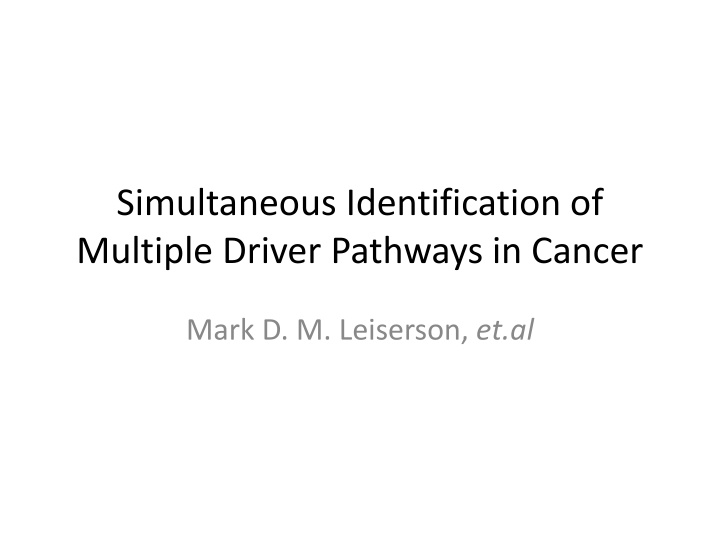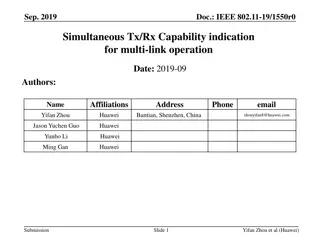Simultaneous Identification of Driver Pathways in Cancer
Goal: Distinguish functional driver mutations from random passenger mutations in cancer. Multi-Dendrix method emphasizes high coverage and exclusivity. Justification by Vandin et al. (2012) supports this approach. Dendrix method addresses the Maximum Coverage Exclusive Submatrix and Maximum Weight Submatrix Problems. Limitation of Dendrix leads to the development of the Multi-Dendrix algorithm to handle non-exclusive mutations.
Download Presentation

Please find below an Image/Link to download the presentation.
The content on the website is provided AS IS for your information and personal use only. It may not be sold, licensed, or shared on other websites without obtaining consent from the author.If you encounter any issues during the download, it is possible that the publisher has removed the file from their server.
You are allowed to download the files provided on this website for personal or commercial use, subject to the condition that they are used lawfully. All files are the property of their respective owners.
The content on the website is provided AS IS for your information and personal use only. It may not be sold, licensed, or shared on other websites without obtaining consent from the author.
E N D
Presentation Transcript
Simultaneous Identification of Multiple Driver Pathways in Cancer Mark D. M. Leiserson, et.al
Goal To distinguish the functional driver mutations responsible for cancer development from the random passenger mutations that have no consequences for cancer.
Multi-Dendrix Dendrix De novo Driver Exclusivity Important Assumption: 1) High Coverage- most patients have at least one mutation in the set, i.e, set of potential mutated genes of a particular pathway 2) High Exclusivity- nearly all patients have no more than one mutation in the set
Justification by the author From Vandin, et al, 2012
Dendrix - Method From Vandin, et al, 2012
Dendrix Method Maximum Coverage Exclusive Submatrix Problem: Given an m*n mutation matrix A and an integer k>0, find a mutually exclusive m*k submatrix of M of k columns (genes) of A with the largest number of nonzero rows (patients). Coverage Overlap Denote the set of patients in which g is mutated Denote the set of patients in which at least one of the genes in M is mutated Weight From Vandin, et al, 2012
Dendrix Method Maximum Weight Submatrix Problem: Given an m * n mutation matrix A and an integer k >0, find the m * k column submatrix M of A that maximizes W (M). Problem Computationally Difficult to Solve Size k = 6 of 20,000 genes 10^ 23 subsets Solution A greedy Algorithm for independent genes Markov Chain Monte Carlo (MCMC) From Vandin, et al, 2012
Limitation of Dendrix Mutations in different pathways may not be mutually exclusive. Mutations in different pathways may exhibit significant patterns of co-occurrence across patients. Solution -> Multi-Dendrix Algorithm
Multi-Dendrix Algorithm 1) Find sets of genes with high coverage as an integer linear program (ILP) 2) Generalize the ILP to simultaneously find multiple driver pathways 3) Additional Analysis: Subtype-specific mutations, stability measures, permutation test, compute enrichment states
Multi-Dendrix Method - the same as the first step of Dendrix Maximum Coverage Exclusive Submatrix Problem: Given an m*n mutation matrix A and an integer k>0, find a mutually exclusive m*k submatrix of M of k columns (genes) of A with the largest number of nonzero rows (patients). Coverage Overlap Denote the set of patients in which g is mutated Denote the set of patients in which at least one of the genes in M is mutated Weight
ILP- Integer Linear Programming Mathematical optimization or feasibility program where variables are restricted to be integers From Wikipedia
ILP for the Maximum Weight Submatrix Problem Mutation matrix: For each gene j, a gene set M is determined by For each patient I, the coverage is determined by
Denote the set of patients in which g is mutated Denote the set of patients in which at least one of the genes in M is mutated
Multiple Maximum Weight Submatrices Problem Multiple Maximum Weight Submatrices Problem: Given an m*n mutation matrix A and an integer t>0, find a collection M = { M1, M2, ., Mt} of m*k column submatrices that maximizes
Multi-Dendrix Results on the GBM Dataset























